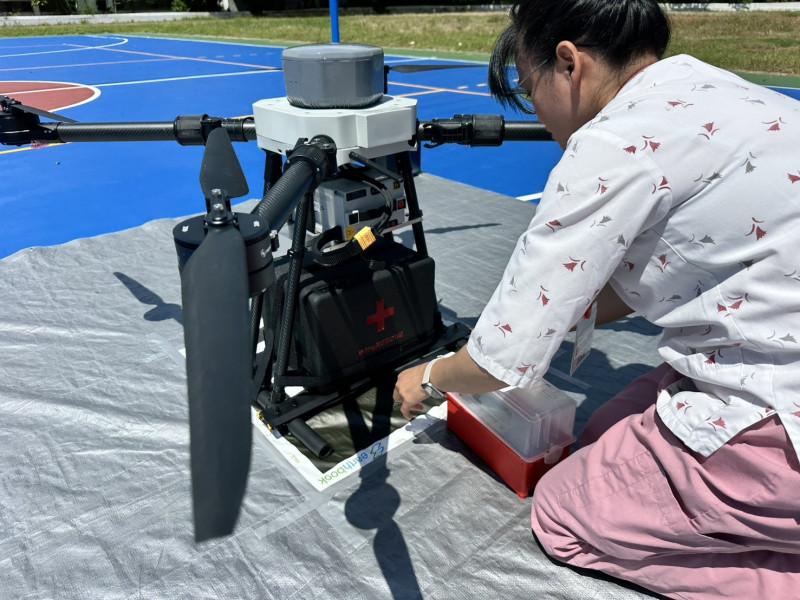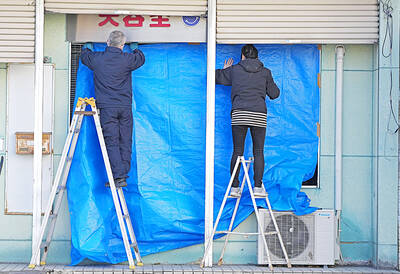The Ministry of Health and Welfare has started using drones to deliver medicine for the first time to ensure that people with chronic illnesses stuck at home due to recent heavy rains do not run out of medication.
Health departments that need to deliver emergency medicine to areas that are isolated due to damaged roads can apply to use the drone delivery system, Department of Information Management Director Lee Chien-chang (李建璋) said yesterday.
This would reduce risks for medical delivery personnel and ensure that people living in remote areas receive consistent treatment, Lee said.

Photo courtesy of the Ministry of Health and Welfare
The Centers for Disease Control previously evaluated using drones to deliver vaccines or snake antivenom, Lee said.
Last year, his department cooperated with the Ministry of Economic Affairs and Civil Aviation Administration to experiment with drone drug delivery in Hualien County, Lee said.
They conducted several successful flight tests to confirm the delivery method’s feasibility, he said.
Modern drones can be controlled through 4G and 5G wireless networks, even when they are beyond the pilot’s visual line of sight, Lee said.
Even if the connection is temporarily lost, drones can rely on autopilot to successfully complete their task, overcoming challenging terrain and demonstrating strong resilience and operational stability, he said.
Food and Drug Administration Director-General Chiang Chih-kang (姜至剛) said that in the event of disasters or emergencies, medical drone deliveries are not subject to a restriction in the Pharmaceutical Affairs Act (藥事法) that pharmacists need to personally deliver medicine.
The law has been relaxed to fully support technological assistance in emergency medical care, Chiang said.
Lee said there are currently three to five drones conducting medical deliveries, each of which can carry up to 3kg.
The period after heavy rains when roads are blocked and awaiting repair is a good time for drones to deliver medicine, he said, adding that priority would be given to areas with high feasibility and urgency.
If there are nurses stationed in the area, the drone would first deliver the medicine to the nurse, who would then pass it on to the person in need, Lee said.
In areas without nurses, the drone would deliver the medicine directly to the specified location, and a pharmacist would explain how to use the medicine via video chat, he said.

Taiwanese were praised for their composure after a video filmed by Taiwanese tourists capturing the moment a magnitude 7.5 earthquake struck Japan’s Aomori Prefecture went viral on social media. The video shows a hotel room shaking violently amid Monday’s quake, with objects falling to the ground. Two Taiwanese began filming with their mobile phones, while two others held the sides of a TV to prevent it from falling. When the shaking stopped, the pair calmly took down the TV and laid it flat on a tatami mat, the video shows. The video also captured the group talking about the safety of their companions bathing

US climber Alex Honnold is to attempt to scale Taipei 101 without a rope and harness in a live Netflix special on Jan. 24, the streaming platform announced on Wednesday. Accounting for the time difference, the two-hour broadcast of Honnold’s climb, called Skyscraper Live, is to air on Jan. 23 in the US, Netflix said in a statement. Honnold, 40, was the first person ever to free solo climb the 900m El Capitan rock formation in Yosemite National Park — a feat that was recorded and later made into the 2018 documentary film Free Solo. Netflix previewed Skyscraper Live in October, after videos

Starting on Jan. 1, YouBike riders must have insurance to use the service, and a six-month trial of NT$5 coupons under certain conditions would be implemented to balance bike shortages, a joint statement from transportation departments across Taipei, New Taipei City and Taoyuan announced yesterday. The rental bike system operator said that coupons would be offered to riders to rent bikes from full stations, for riders who take out an electric-assisted bike from a full station, and for riders who return a bike to an empty station. All riders with YouBike accounts are automatically eligible for the program, and each membership account

A classified Pentagon-produced, multiyear assessment — the Overmatch brief — highlighted unreported Chinese capabilities to destroy US military assets and identified US supply chain choke points, painting a disturbing picture of waning US military might, a New York Times editorial published on Monday said. US Secretary of Defense Pete Hegseth’s comments in November last year that “we lose every time” in Pentagon-conducted war games pitting the US against China further highlighted the uncertainty about the US’ capability to intervene in the event of a Chinese invasion of Taiwan. “It shows the Pentagon’s overreliance on expensive, vulnerable weapons as adversaries field cheap, technologically